Judenplatz: The Viennese Square That Speaks to Europe.
From the Enlightenment to the Holocaust, from the EU to Ukraine—in Judenplatz, memory meets urgency, and values face their ultimate test. Here, since 2019, the best minds call us to think. And to act.
Fire, the wheel, navigation, cities. We list these as humanity's first great inventions. Every civilization defined itself when humans transformed from nomads to settlers. They formed the clusters we call cities.
But not all urban spaces are universal. Not the public square.
By that I mean the open space where people come together: to trade, to talk, to pass time. To pray. To protest. A shared space for civic life. This kind of square — the Piazza, Place, Platz, Plaza, Praça, Plac, Πλατεία, Plóshcha — is one of Europe’s deepest and most enduring urban ideas. And still today, one of its landmarks. Look at many suburban areas in North America, or even at big cities elsewhere in the world: the square may not exist at all, or might be no more than a traffic junction.
The square as a social space is a European invention.
It reaches far back. It began with the Ancient Greek ἀγορά (agora) — a space for gathering, speaking, deciding — where democracy was first given form. The agora became Rome's Forum. Then, in the Middle Ages, the market square. Then the grand, theatrical plazas of the Renaissance and Baroque. Then, in modern times, the monumental, ideological squares. Between and throughout, countless small squares functioned as outdoor living rooms. This tradition is especially Italian. Like espresso and aperitivo, it spread north, west, and east.
European squares are open books on European history. Foods and aromas have mixed in these spaces. Revolts and revolutions have erupted. Constitutions have been written. Great protests and celebrations have unfolded. Books and people have burned. Religions have been contested. New faiths have emerged. Squares have opened to the world. They have also locked away the unwelcome. Ghettos were shaped here.
Each square tells a different version of the European story. Each one has its own language, its own style, its own contradictions—sometimes living side by side. None is a copy of the other.
And one of them, for some years now, has decided to speak directly to Europe. A place that reflects the continent’s pain and richness — in stone, in words etched into the ground and walls, in words.
This is the story of Judenplatz, in Vienna.
And of its “Speech to Europe.”
A square. A time machine.
Judenplatz sits in Vienna's Innere Stadt, 500 meters west of St. Stephen's Cathedral. It's not a square with heavy foot traffic. Nestled in the center of a quadrilateral surrounded by car streets, Judenplatz forms the heart of a pedestrian area.
You have to WANT to come here.
Maybe you’re heading to the Artis International Cinema — not only a local favourite, but also one of the oldest movie theaters in Europe, founded in 1914. Or you come with a tour group. These circle the historic center and stop here to explain the Jewish quarter's history. The groups pause for just a few minutes. Often they're aboard those strange two-wheeled contraptions called Segways. Just enough time to tell who lived here, what happened, point out the Holocaust memorial. Then they glide away.
The square is pedestrian-only, it’s true. So at least it spares us Vienna's kitschy horse-drawn carriages and their smell. But not these humans on two wheels: equally kitsch.
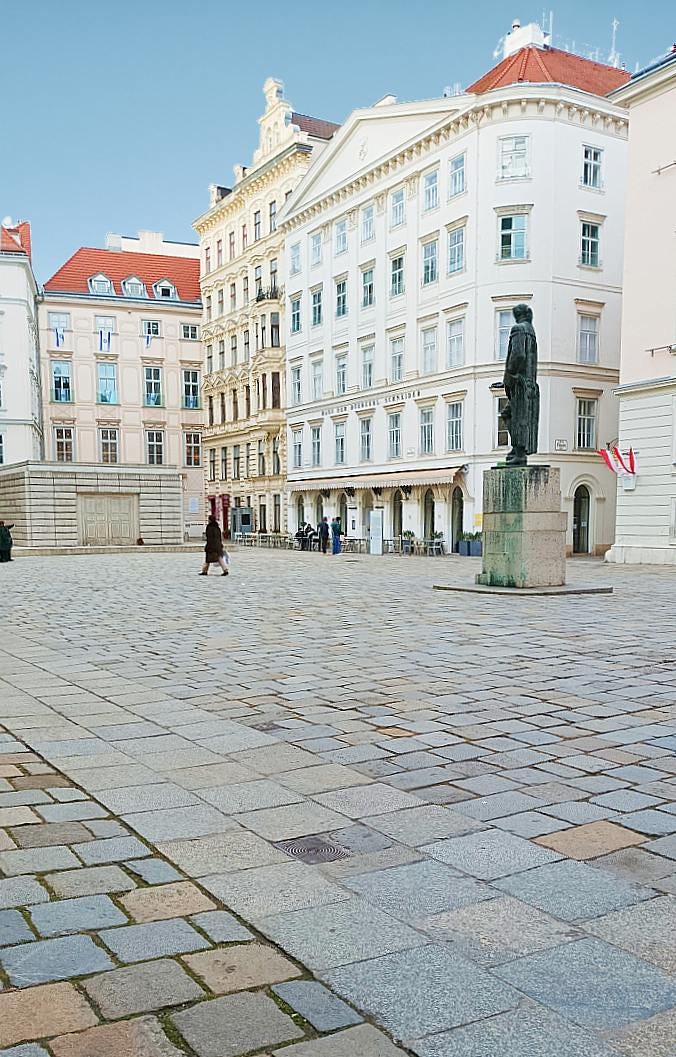
Then, there’s a third reason to come here. To find a moment of quiet — especially when the city is full of visitors. Three small restaurants have outdoor seating from May through October. But this remains a place where you can find peace.
Even meditate.
Even travel through time.
The square has changed significantly during my lifetime, yet its baroque structure remains intact. The facades are the same ones Mozart would have seen in 1783, when he lived in a third-floor apartment at what is now number 3. He stayed there until 1784, hosting house balls where male guests paid two guilders admission. Those years were musically prolific, though his compositions alone couldn't secure a decent income.
I like to imagine him pausing outside, before heading home, quietly humming a melody from that creative period.

But in this square, your imagination can travel even further back in time. Behind the Baroque facades and beneath their foundations lies the medieval period.
This is ancient Austria — the Austria before the Habsburgs, under the rule of the Babenberg dynasty. It was during their reign, around 1150, that the first Jewish communities settled in Vienna. They arrived from Germany, Bohemia, and Moravia, invited by the Babenberg dukes, who sought their financial and commercial expertise. At that time, the Jewish cultural heart of Europe was further west — in the cities of Mainz, Worms, and Speyer. Yet here, too, a vibrant community began to thrive.
By around 1400, some 800 Jewish inhabitants lived around what we now call Judenplatz, in a quarter of about 70 houses — not a ghetto, but a strategically placed neighborhood just steps away from the Herzogburg, the seat of Austria’s first dukes.
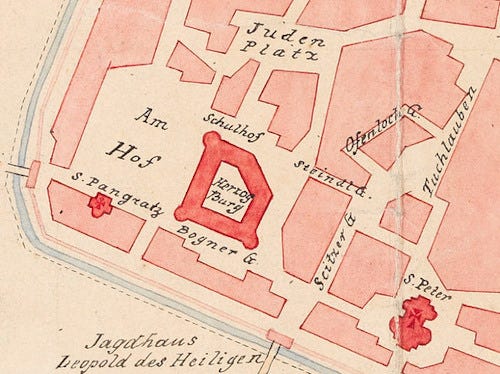
Back then, the square was known as Schulhof. The name had nothing to do with the German word Schule (school), but came instead from the Hebrew shul (שול), meaning synagogue. And indeed, a magnificent stone synagogue once stood here, taking up a third of the square’s western edge.
This was Vienna’s Jewish piazza — the community’s commercial center, its hub of daily life, and its spiritual core. And yes — it’s not so difficult to imagine that older world, if the conditions are right.
My own epiphany happened here in the early 1990s.
I was sitting at a table in a beer café. Summer. The heat was overwhelming. But in the evening, a light breeze began to stir. Just enough to breathe again. The square was almost empty.
At the time, there was no Holocaust memorial yet. No branch of the Jewish Museum at number 8. That Baroque building hosted some kind of study center back then — a Yeshiva, perhaps? I can’t say for certain. What I remember clearly is this: the windows were open. And I heard singing. Beautiful, flowing singing.
From that house — with its Baroque facade and medieval foundations — the Jewish soul of this place seemed to emerge. The breath of that soul drifted across the square. Past Mozart's house. It reached the statue of Gotthold Ephraim Lessing, seemingly to embrace it. Lessing: the Enlightenment poet, the admirer of Jewish culture, the playwright who authored Nathan the Wise. The most beautiful parable ever written on interfaith tolerance.
It was a moment. My epiphany. I was standing in the heart of European history. Between its ideals, its failures, and its richness.
The end was not the end.
The life of that flourishing community came to a brutal end in 1421. It had begun a decade earlier, when the fourteen-year-old Albrecht became Duke of Austria — after years of disputes between his guardians. As often in history, it was a matter of money. And Albrecht needed it badly. One of his first decisions was to impose heavy new taxes on the Jewish community.
When there was nothing left to take, the next phase began — with accusations.
The same ones that all of Europe used time and again to vent their anger on the Jews. Ritual murders. Desecration of the Host. In the Austrian case, also collaboration with the hated Hussites, the heretical reformers of nearby Bohemia.
In March 1421, it all reached a bloody climax.
The first wave involved mass arrests. Starvation. Torture. Executions. Children were subjected to coercion: tricked into eating unclean foods, or forcibly baptized. The poor were deported to Hungary. The wealthy — imprisoned.
The last remaining Jews sought refuge in their synagogue at Judenplatz. After three days under siege, weakened by hunger and thirst, they chose Kiddush Hashem — sanctifying the name of God through martyrdom. They set fire to the synagogue and perished in the flames, rather than face forced conversion. Collective suicide.
A few days later, approximately two hundred survivors of the Jewish community were led to the pyre at the "Gänseweide" (goose pasture) — today's Krieglergasse in Vienna´s 3rd District. They were burned alive before the public.
In the aftermath, Duke Albrecht issued a decree banning all Jews from ever settling in Austria again. The event became known as the Wiener Gesera. Jewish homes and possessions were confiscated — sold off or handed out. The stones of the destroyed synagogue were reused to build Vienna’s old university.
The image of a collective suicide, of bodies on a pyre — sadly, it’s not difficult to imagine. There is no country in Europe where something similar didn’t happen during the fifteenth and sixteenth centuries. The same centuries we often celebrate as the end of the Middle Ages and the dawn of modernity.
And here, in Judenplatz, the memory is not only vivid — it is, astonishingly, still visible. And readable.
Because – incredibly, or perhaps deliberately, to never stop remembering – on the facade of number 2, the so-called Jordan-Haus, there is still affixed a commemorative stele. This house stands behind the statue of Lessing and faces the Holocaust Memorial. The stele reads:
«Flumine Jordani terguntur labe malisque corpora cum cedit, quod latet omnes nefas. Sic flamma assurgens totam furibunda per urbem 1421 Hebraeum purgat crimina saeva canum. Deucalioneis mundus purgatur ab undis Sicque iterum poenas igne furiente luit»
“The floods of the Jordan cleansed the bodies of filth and evil. Everything hidden and sinful was swept away. Thus, in 1421, flames rose in fury throughout the city to purge the savage crimes of the Hebrew dogs. As the world was once cleansed by the Flood, so it now pays again — by raging fire.”
A text of horrifying clarity. Etched in stone. Still there.
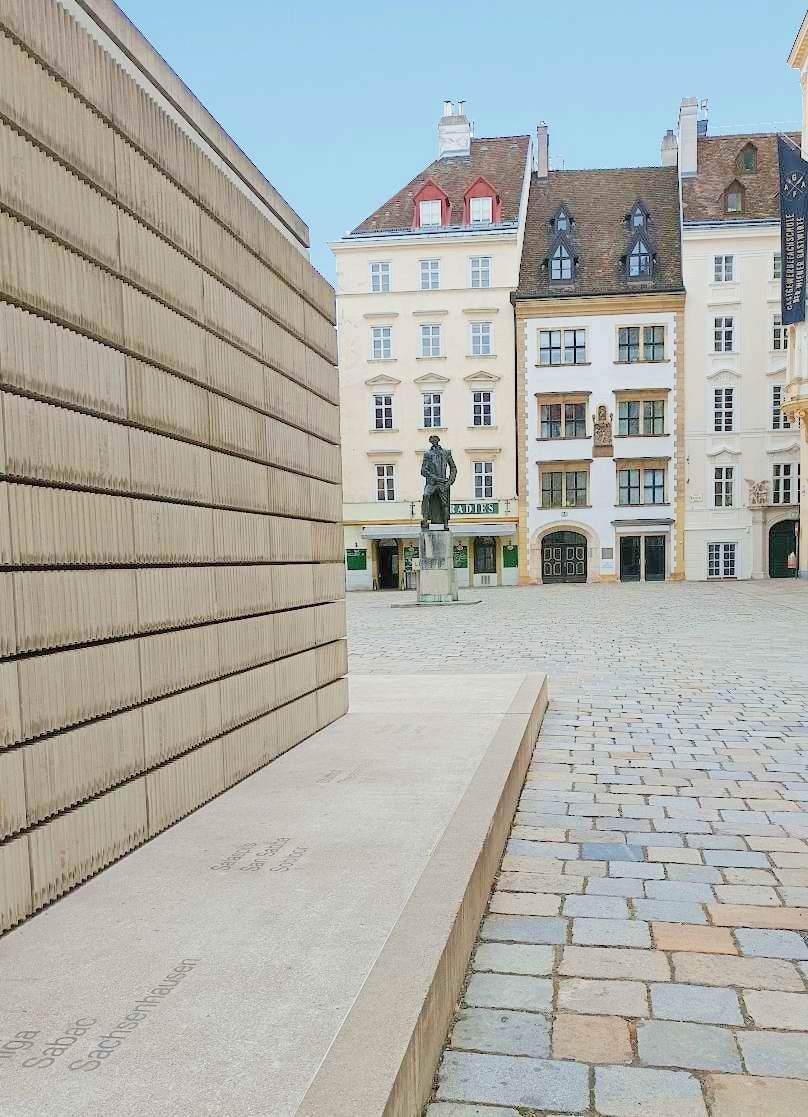
But the Jews came back.
Nach und nach. Un poco alla volta. Bisl bay bisl. Little by little.
In precarious conditions, they resettled outside Vienna — and eventually, again, inside the city walls. At least those who could afford the heavy residency tax imposed specifically on them.
Then, even Austria caught the wind of the Enlightenment. It came in the form of Emperor Joseph II — a figure still too little studied today. The son of Maria Theresa, less famous than his mother, but the author of one of the most radical reform agendas in Europe. He became emperor in 1765, and over time, his reputation spread far beyond the Habsburg lands1.
Drawn by this progress, the great writer Gotthold Ephraim Lessing (1729–1781) came to Vienna in 1775. He came to learn, to exchange ideas, to imagine new futures. And he met the Emperor himself, who granted him an audience.
Lessing, today, is remembered above all for one vision: A Europe in which the monotheistic religions can and must live together — because, simply, there can be no single “true” religion. All faiths, in the end, originate from God. And for that reason, they must coexist — like brothers and sisters.
»Und ist denn nicht das ganze Christentum aufs Judentum gebaut? Es hat mich oft geärgert, hat mir Tränen gnug gekostet, Wenn Christen gar so sehr vergessen konnten, Daß unser Herr ja selbst ein Jude war.«
“Isn’t all of Christianity built upon Judaism? It has often pained me, brought me to tears, when Christians could so easily forget that our Lord himself was a Jew.”
G.E. Lessing, Nathan the Wise, 1779, Act IV, Scene 7
Just a few years after that meeting, in 1782, Emperor Joseph II issued the Edict of Tolerance — a landmark reform specifically aimed at improving the status of Jews in the Habsburg Empire.
It lifted many of the harshest restrictions: Jews could now settle in Vienna and other cities in Lower Austria. They could send their children to public schools and universities. They could learn trades, open businesses, own factories. Gone were some of the most humiliating impositions — like wearing identifying badges, or paying special taxes for being Jewish, or for their cattle.
It was the beginning of a new age. An age of assimilation, but also one of extraordinary contribution: to the arts, to music, science, philosophy, daily life. Jewish life became part of what we call Viennese culture.
Fast forward about 150 years. In 1935, Vienna paid homage to Lessing. A bronze statue of him was unveiled here, in Judenplatz — the very square where so much Jewish history had unfolded.
What a dream, no? What a perfect ending to this long, winding story. But that — tragically — was not the end. In 1938, Austria was annexed by Nazi Germany. The statue of Lessing was removed in 1939. In 1940, it was melted down — its bronze used to make weapons. A new chapter was beginning. Not just for this square, but for the whole of Europe.
This monument shouldn’t be beautiful. It must hurt.
After the greatest tragedy in its history, Europe healed. So did Vienna. And Lessing’s statue returned as well. A new version was created in 1968 and, in 1981, it finally took its rightful place again in this square.
The 80s. The years that shaped the culture of remembrance across Germany and Austria.
Not without intense debates and hypocrisy, as I recalled a few months ago in a series of posts. Many Austrians still clung to the idea of being “Hitler’s first victims,” citing the 1938 Anschluss. Then, in 1986, the Kurt Waldheim wartime past scandal erupted. The former UN Secretary-General was running for Austrian Presidency when revelations of his service in Greece and Yugoslavia during World War II sparked international controversy. His knowledge of Nazi atrocities as an intelligence officer in Nazi Germany's Wehrmacht became known. He became President from 1986 to 1992.
And Austria had to prove to the world that it was finally confronting its past.
In 1988, the Mahnmal gegen Krieg und Faschismus (Memorial Against War and Fascism) was unveiled in front of the Albertina gallery. Many opposed it before. Many were disappointed after, for different reasons.
The most vocal critic was the Austrian Nazi hunter Simon Wiesenthal. He felt it portrayed Jewish victims in an undignified manner. And it was too generic about the victims. Not unlike the debate about Berlin's Neue Wache later in 1993, criticized as "too all-inclusive." I agree.

Wiesenthal insisted there was an urgent need for a specific, respectful memorial dedicated solely to Austrian Jewish victims. That new monument came — right here in Judenplatz. During construction, workers discovered, to their surprise, that the remains of Vienna’s medieval synagogue lay directly beneath the planned location.
The memorial was unveiled in 2000, and it shocked the Viennese — just as Berliners would be shocked five years later by their own Holocaust Memorial.
Both works were deliberately uncomfortable. Vienna’s memorial was conceived as a “counter-monument.” As Wiesenthal said at the unveiling: “This monument shouldn’t be beautiful. It must hurt.”
It was designed by English artist Dame Rachel Whiteread. The structure is a concrete cube, 10 by 7 meters at its base, 3.8 meters high. Its outer walls resemble rows of books turned spine-inward — the titles hidden, unreadable, unknowable. These nameless books represent the silenced individual stories of the victims, a void that cannot be fully recovered or told.
There are doors too — cast with their panels inside out, no doorknobs or handles. They symbolically suggest an entry or exit that is, in reality, impossible. A past that cannot be undone or re-entered. A room forever closed.
An inscription lies embedded in the concrete at the foot of the sealed doors, in German, Hebrew, and English:
»Zum Gedenken an die mehr als 65.000 österreichischen Juden, die in der Zeit von 1938 bis 1945 von den Nationalsozialisten ermordet wurden.«
“In commemoration of more than 65,000 Austrian Jews who were killed by the Nazis between 1938 and 1945.”
Around the base, 41 place names are engraved — camps to which Austrian Jews were deported and murdered.
This memorial, impossible to ignore due to its size and position, has changed Judenplatz forever.
I confess: the first time I saw it, I missed the square as it had been before. But now I understand. The monument is a node in a network of memory: surrounded by baroque façades, standing over one of Europe’s oldest synagogues, looking across at its friends — like the bronze Lessing — and its foes — like the Jordan House, with its obscene stele.
Around it, summer life continues. People eat, drink, play. Children run. Segways roll past; people glance and move on.
But since 2019, some also gather and listen — to scholars, writers, thinkers — speaking to Europe, about its past and its future. Behind them: the Holocaust Memorial of invisible books. A backdrop. A starting point.
This was Europe’s past.
What about its future?
A Speech To Europe.
„Eine Rede an Europa“ (“A Speech to Europe”) is an annual public event initiated by the Austrian ERSTE Foundation to commemorate Europe Day (9 May). But it is not a celebration in the conventional sense—there are no medals, no official rituals, no self-congratulatory speeches.
Since 2019, this series has transformed Vienna’s Judenplatz into a space where memory and present-day political urgency meet. It’s about Europe’s past—but even more, about Europe’s present and future. The speeches delivered here are not ceremonial; they are challenging, reflective, and provocative.
Timothy Snyder inaugurated the series in 2019 with a powerful call:
“Europe, you are more than your myths.”
He urged Europeans to move beyond self-soothing narratives about peace and unity. The EU, he argued, was not simply born from the will of nation-states to cooperate, but from the collapse of European empires—France, Germany, Belgium, Italy, the Netherlands—all of which had to come to terms with the end of colonial rule. That dismantling was Europe’s greatest challenge—and perhaps its greatest achievement: creating a new kind of political project in the wake of empire.
“The EU became the largest economy in the history of the world… a series of contiguous functioning welfare states and democracies. There is nothing like this anywhere else.”
FULL TEXT SPEECH TO EUROPE 2019
But Snyder warned of new imperial threats: authoritarian regimes like Russia, and the borderless dominions of digital empires. Europe’s strength, he insisted, lies in its ability to resist monopolies, uphold education that defends our shared humanity, commit to factual truth, and protect democratic sovereignty. Only by doing so can Europe remain a source of hope—for itself and for the world.
Three years later, amid the war in Ukraine, human rights lawyer and Nobel Peace Prize laureate Oleksandra Matviichuk returned to the theme of empire in her address titled:
“No Peace without Freedom, No Justice without Law.”
Standing in Judenplatz, she posed a sharp question: Will Europe allow military power to dictate the rules again, or will it defend the law and the people?
FULL TEXT OLEKSANDRA MATVIICHUK´S SPEECH “No Peace without Freedom, No Justice without Law.”
She praised Europe’s internal achievements—rule of law, economic prosperity—but reminded the audience of its failures, when it failed to stand up: for Bosnia, in Chechnya, in Crimea, and again in Ukraine. Europe fails when it is afraid, when it abandons occupied peoples to repression, prisons, and torture. But Europe can still succeed—by enforcing the very principles it professes, starting with justice:
“We must create an international tribunal and bring Putin, Lukashenka, and other war criminals to justice. Yes, this is a bold step. But we must demonstrate that democracy is effective, that the rule of law works, and that justice prevails.”
Even more chance for success: Thanks to its multiculturalism and complex history, Europe has the potential to rethink what humanism means in an era of rapid technological progress. To give new dimensions to the meaning of humanity. No other region in the world is better positioned to do so—because no other has so consciously built itself on universal values.
And it is precisely universal values that form the core of Omri Boehm’s controversial 2024 address. A German-Israeli philosopher and “decided universalist,” Boehm was the most heavily guarded speaker in the series’ history. He has been openly critical of Israel’s foundation, arguing that it cannot simultaneously be a Jewish state and a liberal democracy—a stance that has drawn intense criticism, including from Austrian-Israeli communities.
“Human dignity is inviolable”
FULL TEXT OMRI BOEHM´S SPEECH “Europe and its victims”
Yet Boehm’s hour-long speech was a natural continuation of Snyder’s. If Snyder had opposed myth with history, Boehm added a third axis: values. The values of Enlightenment and Humanism—universal dignity, reason, freedom—are, he said, not merely European traditions but Europe’s binding ethical legacy. He reminded his audience that Article 1 of the German Constitution, Die Würde des Menschen ist unantastbar, is also Article 1 of the EU Charter of Fundamental Rights, and the moral foundation of the UN’s Universal Declaration of Human Rights.
Framed by the Holocaust Memorial behind him and the statue of Enlightenment philosopher Lessing in front, Boehm pleaded with Europe not to retreat into nationalism, not to allow the memory of past guilt to paralyze its moral clarity today:
“This, then, would be my call to Europe: Insist on the reality of your ideals… They cannot be dependent on or limited by historical responsibility.”
Europe, he argued, has a duty to uphold universal dignity everywhere—even when doing so means confronting uncomfortable truths, including in Israel, a country founded by the children of Enlightenment Europe but which, in Boehm’s view, fails to apply those values universally.
Lea Ypi, political philosopher and author of Free: Coming of Age at the End of History (a must-read), delivered the 2025 Rede an Europa.
Born in communist Albania, Ypi stood once again between the same two monuments: Enlightenment ahead, Holocaust behind. Two poles of the European conscience. Her speech was a direct challenge to Europe’s approach to migration—which she framed not as a problem, but a symptom of deeper structural injustice.
“On Migration”
“If you support a system of selective immigration and agree that the West should recruit highly qualified migrants and reject the others, you are effectively endorsing a form of exploitation.”
FULL SPEECH LEA YPI´S “On Migration”
Furthermore, in the current European debate, migrants serve as "scapegoats" for Western societies' failures. These failures include the ever-widening gap between the representatives and the represented, the challenge of social justice, and the inability to formulate an alternative vision to the current world order.
But is migration the problem or just a symptom of a crisis whose roots lie in the sick relationship between Capitalism and Democracy? A relationship where neither national participation nor international solidarity is truly realized.
And so, she concluded, the ultimate test of Europe is not whether it makes the West “great again,” but whether it remains faithful to its most radical promises: “…the commitment to freedom, equality, and a world in which no one is forced to leave their home.”
Four speeches. Four voices. Four different biographies, each reflecting a different aspect of Europe´s identity and challenges. But all of them find common ground in Judenplatz. There are many places in Europe where speeches can be delivered. But few offer what Judenplatz does: a spatial and symbolic condensation of Europe’s highest hopes and darkest failures. A place where Lessing and the Shoah speak across time and look at each other. Where memory demands not reverence but responsibility. Where ideas become urgent calls to action.
The square speaks to Europe.
We all need to listen.
I don't know if these two masterworks exploring Joseph II of Austria have been translated into English: François Fejtö's "Joseph II. un Habsbourg révolutionnaire essai biographique" (Joseph II: A Revolutionary Habsburg - A Biographical Essay, 1982) and Monika Czernin's "Der Kaiser reist inkognito: Joseph II. und das Europa der Aufklärung" ("The Emperor Travels Incognito: Joseph II and the Europe of Enlightenment", 2021)


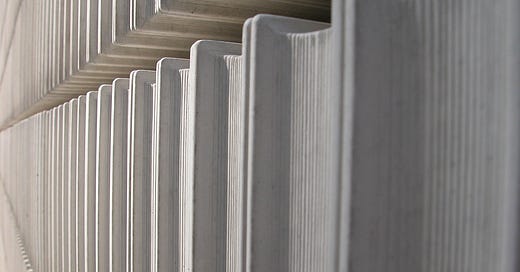


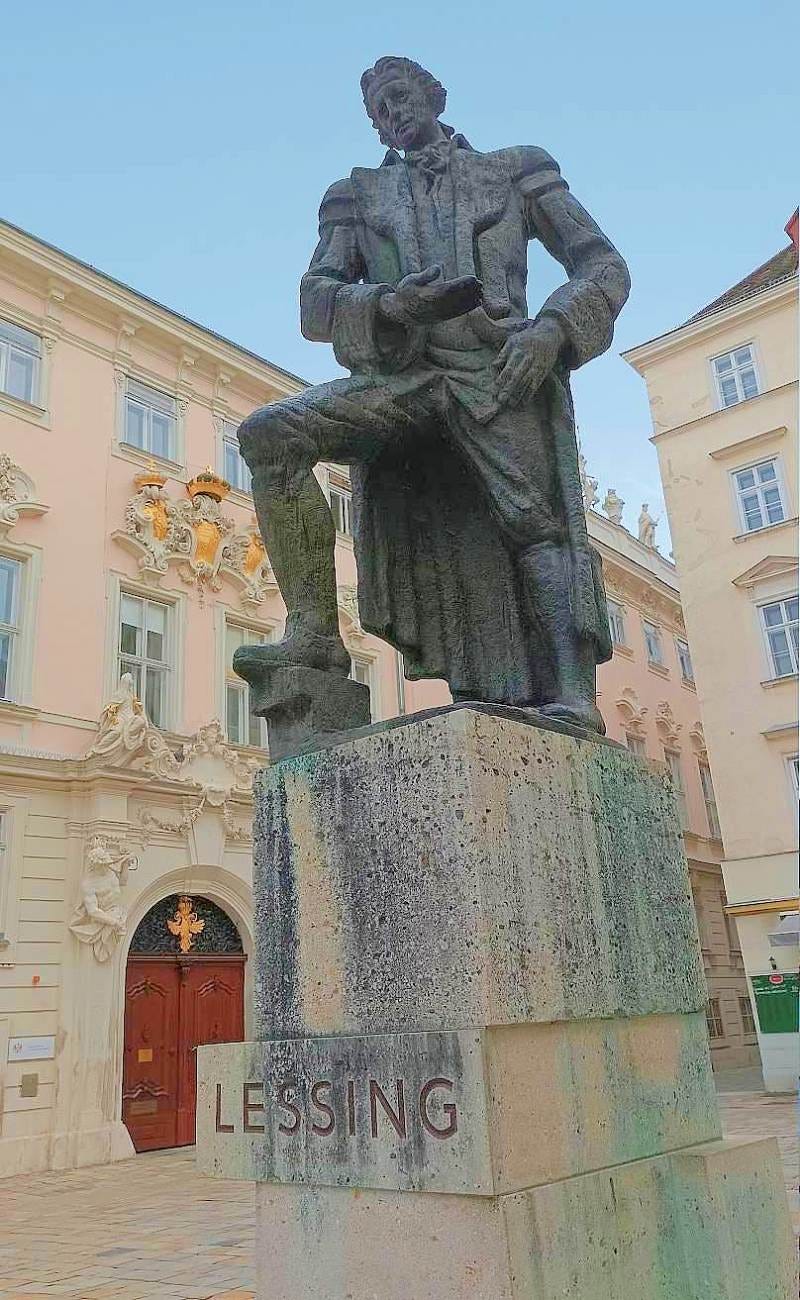
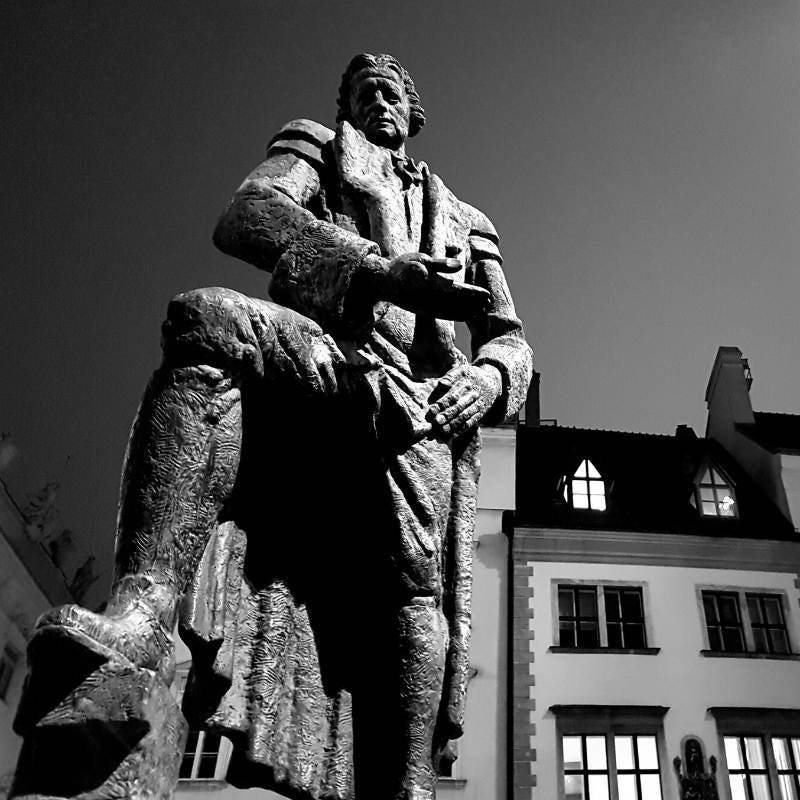


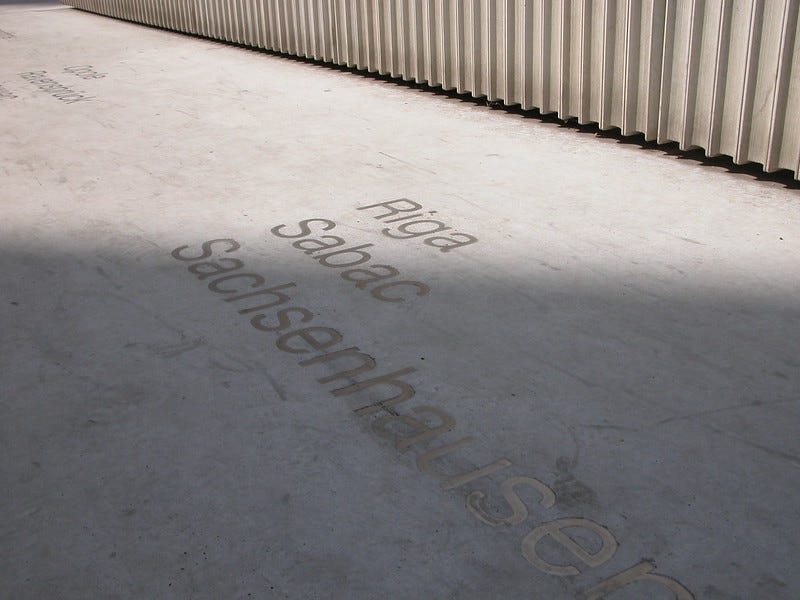

Thank you for sharing. See also "The History of Jewish Vienna. From medieval times to modern day, uncover the compelling history of the Jews of Vienna and its haunting lessons about antisemitism." HERE: https://substack.com/home/post/p-150582621